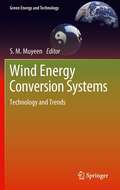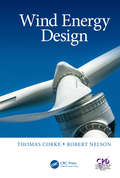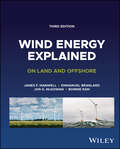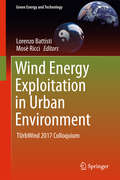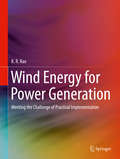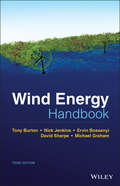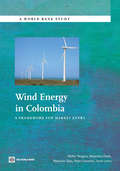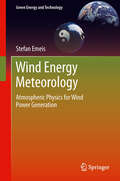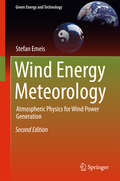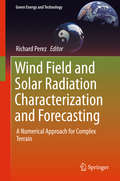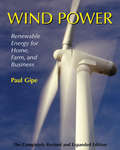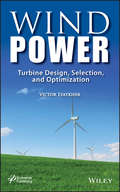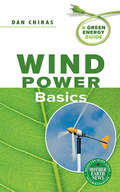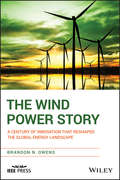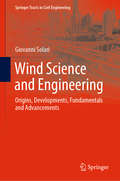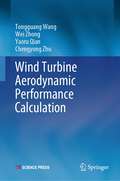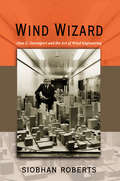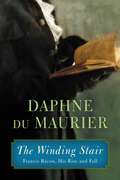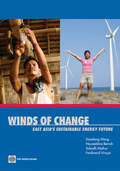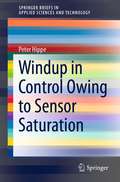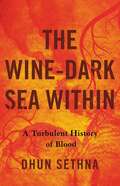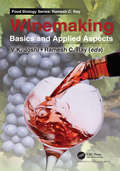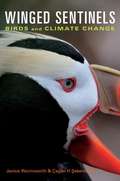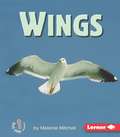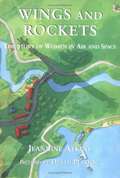- Table View
- List View
Wind Energy Conversion Systems
by S. M. MuyeenWind Energy Conversion System covers the technological progress of wind energy conversion systems, along with potential future trends. It includes recently developed wind energy conversion systems such as multi-converter operation of variable-speed wind generators, lightning protection schemes, voltage flicker mitigation and prediction schemes for advanced control of wind generators. Modeling and control strategies of variable speed wind generators are discussed, together with the frequency converter topologies suitable for grid integration. Wind Energy Conversion System also describes offshore farm technologies including multi-terminal topology and space-based wind observation schemes, as well as both AC and DC based wind farm topologies. The stability and reliability of wind farms are discussed, and grid integration issues are examined in the context of the most recent industry guidelines. Wind power smoothing, one of the big challenges for transmission system operators, is a particular focus. Fault ride through and frequency fluctuation mitigation using energy storage options are also covered. Efficiency analyses are presented for different types of commercially available wind turbine generator systems, large scale wind generators using superconducting material, and the integration of offshore wind and marine current farms. Each chapter is written by a leader in the wind energy arena, making Wind Energy Conversion System a valuable reference for researchers and students of wind energy.
Wind Energy Design
by Thomas Corke Robert NelsonWind Energy Systems is designed for undergraduate engineering courses, with a focus on multidisciplinary design of a wind energy system. The text covers basic wind power concepts and components - wind characteristics and modeling, rotor aerodynamics, lightweight flexible structures, wind farms, aerodynamics, wind turbine control, acoustics, energy storage, and economics. These topics are applied to produce a new conceptual wind energy design, showing the interplay of various design aspects in a complete system. An ongoing case study demonstrates the integration of various component topics, and MATLAB examples are included to show computerized design analysis procedures and techniques.
Wind Energy Explained: On Land and Offshore
by James F. Manwell Emmanuel Branlard Jon G. McGowan Bonnie RamWIND ENERGY EXPLAINED Authoritative and bestselling textbook detailing the many aspects of using wind as an energy source Wind Energy Explained provides complete and comprehensive coverage on the topic of wind energy, starting with general concepts like the history of and rationale for wind energy and continuing into specific technological components and applications along with the new recent developments in the field. Divided into 16 chapters, this edition includes up-to-date data, diagrams, and illustrations, boasting an impressive 35% new material including new sections on metocean design conditions, wind turbine design, wind power plants and the electrical system, fixed and floating offshore wind turbines, project development, permitting and environmental risks and benefits, turbine installation, operation and maintenance, and high penetration wind energy systems and power-to-X. Wind Energy Explained also includes information on: Modern wind turbines, covering the design and their many components such as the rotor, drive train, and generator Aerodynamics of wind energy, covering one-dimensional momentum theory, the Betz limit, and ideal horizontal axis wind turbine with wake rotation Environmental external design conditions, such as wind, waves, currents, tides, salinity, floating ice, and many more Commonly used materials and components, such as steel, composites, copper, and concrete, plus machinery elements, such as shafts, couplings, bearings, and gears Modern design methods, including probabilistic design Environmental effects and mitigation strategies for wind project siting and the role of public engagement in the development process This book offers a complete examination of one of the most promising sources of renewable energy and is a great introduction to this cross-disciplinary field for practicing engineers. It may also be used as a textbook resource for university level courses in wind energy, both introductory and advanced.
Wind Energy Exploitation in Urban Environment: Turbwind 2017 Colloquium (Green Energy And Technology)
by Lorenzo Battisti Mosè RicciThis book presents numerical and experimental research in the field of wind energy exploitation in urban environments. It comprises a selection of the best papers from the international colloquium “Research and Innovation on Wind Energy Exploitation in Urban Environment” (TUrbWind), held in Riva del Garda, Italy in June 2017. The book includes contributions from different research fields in urban wind resources, wind energy conversion systems, and urban integration, mainly focusing on the following topics: · concepts for urban and open landscape micro wind turbines, · integration of micro wind turbines in existing structures, · built-environment and high-turbulence sites’ impacts on urban wind turbines, · measuring and modeling wind resource in built environments, · rotor performance and wake features of micro wind turbines. It is a valuable resource for researchers and practitioners interested in the integration of wind energy systems and turbines in urban areas.
Wind Energy for Power Generation: Meeting the Challenge of Practical Implementation
by K. R. RaoThis far-reaching resource covers a full spectrum of multi-faceted considerations critical for energy generation decision makers considering the adoption or expansion of wind power facilities. It contextualizes pivotal technical information within the real complexities of economic, environmental, practical and socio-economic parameters. This matrix of coverage includes case studies and analysis from developed and developing regions, including North America and Europe, Asia, Latin America, the Middle-East and Africa. Crucial issues to power generation professionals and utilities such as: capacity credits; fuel saving; intermittency; penetration limits; relative cost of electricity by generation source; growth and cost trends; incentives; and wind integration issues are addressed. Other economic issues succinctly discussed inform financial commitment to a project, including investment matrices, strategies for economic evaluations, econometrics of wind energy, cost comparisons of various investment strategies, and cost comparisons with other energy sources. Due to its encompassing scope, this reference will be of distinct interest to practicing engineers, policy and decision makers, project planners, investors and students working in the area of wind energy for power generation.
Wind Energy Handbook
by Tony L. Burton Nick Jenkins Ervin Bossanyi David Sharpe Michael GrahamDiscover this fully updated and authoritative reference to wind energy technology written by leading academic and industry professionals The newly revised Third Edition of the Wind Energy Handbook delivers a fully updated treatment of key developments in wind technology since the publication of the book’s Second Edition in 2011. The criticality of wakes within wind farms is addressed by the addition of an entirely new chapter on wake effects, including ‘engineering’ wake models and wake control. Offshore, attention is focused for the first time on the design of floating support structures, and the new ‘PISA’ method for monopile geotechnical design is introduced. The coverage of blade design has been completely rewritten, with an expanded description of laminate fatigue properties and new sections on manufacturing methods, blade testing, leading-edge erosion and bend-twist coupling. These are complemented by new sections on blade add-ons and noise in the aerodynamics chapters, which now also include a description of the Leishman-Beddoes dynamic stall model and an extended introduction to Computational Fluid Dynamics analysis. The importance of the environmental impact of wind farms both on- and offshore is recognised by extended coverage, which encompasses the requirements of the Grid Codes to ensure wind energy plays its full role in the power system. The conceptual design chapter has been extended to include a number of novel concepts, including low induction rotors, multiple rotor structures, superconducting generators and magnetic gearboxes. References and further reading resources are included throughout the book and have been updated to cover the latest literature. Importantly, the core subjects constituting the essential background to wind turbine and wind farm design are covered, as in previous editions. These include: The nature of the wind resource, including geographical variation, synoptic and diurnal variations and turbulence characteristics The aerodynamics of horizontal axis wind turbines, including the actuator disc concept, rotor disc theory, the vortex cylinder model of the actuator disc and the Blade-Element/Momentum theory Design loads for horizontal axis wind turbines, including the prescriptions of international standards Alternative machine architectures The design of key components Wind turbine controller design for fixed and variable speed machines The integration of wind farms into the electrical power system Wind farm design, siting constraints and the assessment of environmental impact Perfect for engineers and scientists learning about wind turbine technology, the Wind Energy Handbook will also earn a place in the libraries of graduate students taking courses on wind turbines and wind energy, as well as industry professionals whose work requires a deep understanding of wind energy technology.
Wind Energy in Colombia: A Framework for Market Entry
by Walter Vergara Peter Cramton Irene Leino Natsuko Toba Alejandro Deeb Philippe BenoitThe wind regime in Colombia has been rated among the best in South America. However, under the current circumstances, and on its own, the interconnected system would not likely promote wind power. This report is targeted to analysts, planners, operators, generators and decision makers in Colombia and other countries in the region and provides a set of policy options to promote the use of wind power. The potential instruments assessed in this study include financial instruments, government fiscal mechanisms, and adjustments to the regulatory system. The single most effective policy instrument to promote wind power in Colombia consists on valuing the firm energy offered by wind, its potential complementarity to the hydrological regime and enabling wind power an access to reliability payments.
Wind Energy Meteorology
by Stefan EmeisThis book is intended to give an introduction into the meteorological boundary conditions for power generation from the wind, onshore and offshore. It is to provide reliable meteorological information for the planning and running of this important kind of renewable energy. This includes the derivation of wind laws and wind profile descriptions, especially those above the logarithmic surface layer. Winds over complex terrain and nocturnal low-level jets are considered as well. A special chapter is devoted to the efficiency of large wind parks and their wakes.
Wind Energy Meteorology: Atmopsheric Physics For Wind Power Generation (Green Energy And Technology)
by Stefan EmeisThis book offers an introduction to the meteorological boundary conditions for power generation from wind – both onshore and offshore, and provides meteorological information for the planning and running of this important renewable energy source. It includes the derivation of wind laws and wind-profile descriptions, especially those above the logarithmic surface layer, and discusses winds over complex terrains and nocturnal low-level jets. This updated and expanded second edition features new chapters devoted to the efficiency of large wind parks and their wakes and to offshore wind energy.
Wind Field and Solar Radiation Characterization and Forecasting: A Numerical Approach For Complex Terrain (Green Energy And Technology)
by Richard PerezIn addition to describing core concepts and principles, this book reveals professional methodologies and tools used by national agencies and private corporations to predict sites’ potential for wind and solar power generation. Each chapter focuses on a different issue, showing readers the corresponding methodology, as well as examples of how to apply the techniques described. These techniques are explained with step-by-step guides that demonstrate how environmental variables in complex terrains can be characterized and forecasted.The authors present an adaptive finite element mass-consistent model, which computes a diagnostic wind field in the three-dimensional area of interest using observed wind data from measurement stations – data which is then interpolated using a physical model of the wind field in the boundary layer. An ensemble method is presented based on the perturbation of the numerical weather prediction models’ results. The book goes on to explain solar radiation characterization and forecasting. Solar radiation and electrical power generation temporal and spatial variability are discussed and modelled. Different statistical methods are presented in order to improve solar radiation forecasting using ground measurement, numerical weather predictions (NWPs) and satellite-derived data. This book is focused on both probabilistic and point forecast explaining different models and methodologies to improve the forecasting. The results obtained from various simulations around the world are presented in tables. Finally, the book explains a possible methodology to develop a Solar Map taking into account solar radiation, terrain surface conditions and cast shadows.As such, the book provides an overview of the concepts, principles and practices involved in the treatment of environmental variables related to solar radiation or wind fields, especially when complex terrains are involved, offering useful resources for students and researchers alike. It also equips professionals with the methodologies and tools needed to construct environmental variable maps and conduct forecasting for solar radiation and wind fields.
Wind Power: Renewable Energy for Home, Farm, and Business
by Paul GipeWind energy today is a booming worldwide industry. The technology has truly come of age, with better, more reliable machinery and a greater understanding of how and where wind power makes sense-from the independent homestead to a grid-connected utility-wide perspective. Heightened concerns about our environment mean that this resurgence of interest in wind-a natural and widespread power source-is here to stay. "Wind Power" is the completely revised and expanded edition of Paul Gipe's definitive 1993 book, "Wind Power for Home and Business. " In addition to expanded sections on gauging wind resources and siting wind turbines, this edition includes new examples and case studies of successful wind systems, international sources for new and used equipment, and hundreds of color photographs and illustrations.
Wind Power: Turbine Design, Selection, and Optimization
by Victor M. LyatkherAn up-to-date and thorough treatment of the technologies, practical applications, and future of wind power, with the pros and cons and technical intricacies of various types of wind turbines and wind power prediction With the demand for energy outstripping availability from conventional sources such as fossil fuels, new sources of energy must be found. <P><P>Wind power is the most mature of all of the renewable or alternative sources of energy being widely used today. With many old wind turbines becoming obsolete or in need of replacement, new methods and materials for building turbines are constantly being sought after, and troubleshooting, from an engineering perspective, is paramount to the operational efficiency of turbines currently in use. Wind Power: Turbine Design, Selection, and Optimization: Details the technical attributes of various types of wind turbines, including new collinear windmills, orthogonal windmills, non-vibration VAWT wind turbines, and others Covers all the updated protocols for wind power and its applications Offers a thorough explanation of the current and future state of wind power Is suitable not only as a reference for the engineer working with wind power but as a textbook for graduate students, postdoctoral students, and researchers Wind power is one of the fastest-growing, oldest, and "greenest" of the major sources of renewable energy that has been developed, with more efficient and cost-effective technologies and materials now constantly being sought for turbines and the equipment used with them. Here is a comprehensive and thorough review of the engineering pros and cons of using different kinds of wind turbines in different environments, including offshore. With full technical knowledge, engineers, managers, and other decision-makers in the wind energy industry can make more informed decisions about increasing capacity, cost-efficiency, and equipment longevity. Covering the various types of wind turbines available, such as new collinear windmills, orthogonal turbines, and others, this highly technical treatment of wind turbines offers engineers, students, and researchers insight into the practical applications of these turbines and their potential for maximum efficiency.
Wind Power Basics
by Dan ChirasWind energy is the fastest growing source of energy in the world, and by the year 2020 it is projected to supply at least 12 percent of global electrical demand.Wind Power Basics provides a clear understanding of wind and wind energy systems, including turbines, towers, inverters and batteries, site assessment, installation, and maintenance requirements.Whether you're considering your own small-scale wind energy system or just want a straightforward, detailed introduction to the benefits and challenges of this rapidly emerging technology, Wind Power Basics is the guide you need.Dan Chiras is a respected educator and an internationally acclaimed author who has published more than twenty-five books on residential renewable energy and green building, including Power From the Wind.
The Wind Power Story: A Century of Innovation that Reshaped the Global Energy Landscape
by Brandon OwensHelps readers understand and appreciate what the history of wind power can teach us about technology innovation and provides the implications for both wind power today and its future This book takes readers on a journey through the history of wind power in order to show how the technology evolved over the course of the twentieth century and where it may be headed in the twenty-first century. It introduces and examines broad themes such as government funding of wind power, the role of fossil fuels in wind power development, and the importance of entrepreneurs in wind power development. It also discusses the lessons learned from wind power technology innovation and makes them relevant to the understanding of wind power today and in the future. Spanning the entire history of wind power (1888-2018), The Wind Power Story: A Century of Innovation that Reshaped the Global Energy Landscape provides balanced coverage of each decade as well as the important wind power technology innovations that occurred during that time. Compelling from the first page to the last, it offers chapters covering the pioneers of wind power; the age of small wind; wind power in the wake of war; wind power’s use across Europe; government-funded research programs; how Denmark reinvented wind power in the 1970s; the California Wind Rush of the 1980s; wind power’s rise in Spain; America’s wind power starting in the 1990s; India’s wind power path; the wind power surge in China; the globalization of wind power; and much more. In addition, this text: Spans the entire global history of wind power, while weaving together both the historical context and the technical details of wind power innovation Provides historical context for wind power developments and explains the evolution of wind turbine technology in an easy-to-understand manner Discusses the policy, technology, and market evolution of wind power in commonly understood language Offers a review of the surrounding power technology, policy, and market environment throughout the history of wind power A book that both specialists and non-specialists can read in order to understand and appreciate the past, present, and future of wind power technology, The Wind Power Story: A Century of Innovation that Reshaped the Global Energy Landscape will be of great interest to any engineer and any interested readers looking to understand wind power technologies, markets, and policies in one book.
Wind Science and Engineering: Origins, Developments, Fundamentals and Advancements (Springer Tracts in Civil Engineering)
by Giovanni SolariThis book provides an essential overview of wind science and engineering, taking readers on a journey through the origins, developments, fundamentals, recent advancements and latest trends in this broad field. Along the way, it addresses a diverse range of topics, including: atmospheric physics; meteorology; micrometeorology; climatology; the aerodynamics of buildings, aircraft, sailing boats, road vehicles and trains; wind energy; atmospheric pollution; soil erosion; snow drift, windbreaks and crops; bioclimatic city-planning and architecture; wind actions and effects on structures; and wind hazards, vulnerability and risk. In order to provide a comprehensive overview of wind and its manifold effects, the book combines scientific, descriptive and narrative chapters. The book is chiefly intended for students and lecturers, for those who want to learn about the genesis and evolution of this topic, and for the multitude of scholars whose work involves the wind.
Wind Turbine Aerodynamic Performance Calculation
by Tongguang Wang Wei Zhong Yaoru Qian Chengyong ZhuThis book deals with horizontal-axis wind turbine aerodynamic performance prediction methods. It focuses on the traditional and newly-developed methods for the wind turbine aerodynamic performance calculation. The fundamental theories of fluid mechanics essential for understanding the other parts of this book are firstly introduced in Part I, followed by the blade element momentum theory in Part II, with special attentions to a systematic review of various correction models. Part III is mainly about the prescribed and free vortex wake methods, while the state-of-art computational fluid dynamics (CFD) methods are detailed in Part IV.Part III thoroughly describes the prescribed and free vortex wake methods which are still of great importance towards realistic investigation of wind turbine performance. Despite the highly computational cost, the CFD methods in Part IV have received increasing interest from the academic community since they provide more detailed information about the flow field around the wind turbine. This has shed a light in combination with the correction models introduced in Part II on more advanced research for wind turbine.This book is intended for researchers and students interested in aerodynamics of wind turbine and is particularly suitable for practicing engineers in wind energy. Readers can gain a comprehensive understanding in both classical and up-to-date methods for the study of wind turbine aerodynamics. The authors hope that this book can promote the research and development of wind turbines.
Wind Wizard
by Siobhan RobertsWith Wind Wizard, Siobhan Roberts brings us the story of Alan Davenport (1932-2009), the father of modern wind engineering, who investigated how wind navigates the obstacle course of the earth's natural and built environments--and how, when not properly heeded, wind causes buildings and bridges to teeter unduly, sway with abandon, and even collapse. In 1964, Davenport received a confidential telephone call from two engineers requesting tests on a pair of towers that promised to be the tallest in the world. His resulting wind studies on New York's World Trade Center advanced the art and science of wind engineering with one pioneering innovation after another. Establishing the first dedicated "boundary layer" wind tunnel laboratory for civil engineering structures, Davenport enabled the study of the atmospheric region from the earth's surface to three thousand feet, where the air churns with turbulent eddies, the average wind speed increasing with height. The boundary layer wind tunnel mimics these windy marbled striations in order to test models of buildings and bridges that inevitably face the wind when built. Over the years, Davenport's revolutionary lab investigated and improved the wind-worthiness of the world's greatest structures, including the Sears Tower, the John Hancock Tower, Shanghai's World Financial Center, the CN Tower, the iconic Golden Gate Bridge, the Bronx-Whitestone Bridge, the Sunshine Skyway, and the proposed crossing for the Strait of Messina, linking Sicily with mainland Italy. Chronicling Davenport's innovations by analyzing select projects, this popular-science book gives an illuminating behind-the-scenes view into the practice of wind engineering, and insight into Davenport's steadfast belief that there is neither a structure too tall nor too long, as long as it is supported by sound wind science.
The Winding Stair: Francis Bacon, His Rise and Fall
by Daphne Du Maurier"Unlike many authors of popular historical biographies, du Maurier resembled Antonia Fraser in being an indefatigable researcher." --Francis King Many accounts of the life of Francis Bacon have been written for scholars. But du Maurier's aim in this biography was to illuminate the many facets of Bacon's remarkable personality for the common reader. To her book she brought the same gifts of imagination and perception that made her earlier biography, Golden Lads, so immensely readable, skillfully threading into her narrative extracts from contemporary documents and from Bacon's own writings, and setting her account of his life within a vivid contemporary framework.
Winds of Change: East Asia's Sustainable Energy Future
by Noureddine Berrah Ferdinand Vinuya Xiaodong Wang Subodh MathurEast Asia has experienced the fastest economic growth in the world over the last three decades, accompanied by a 10-fold gross domestic product increase and rapid urbanization. Energy consumption has more than tripled during this period and is expected to double over the next 20 years. This remarkable trend has led to twin energy challenges in the region-environmental sustainability and energy security. Written for an audience of energy policy makers and practitioners, Winds of Change explores the region's energy future over the next two decades through two energy scenarios. It outlines the strategic direction East Asia's energy sector must take to meet its growing energy demand in an environmentally sustainable manner, and presents a pathway of policy frameworks and financing mechanisms to get there. The six East Asian countries-China, Indonesia, Malaysia, the Philippines, Thailand, and Vietnam-examined in this book could, with the right policies and financing, stabilize CO2 emissions by 2025, improve their local environment, and enhance energy security without compromising economic growth. They must move their energy sectors toward much higher efficiency and more widespread use of low-carbon technologies, while obtaining substantial financing and low-carbon technologies from developed countries. This clean energy revolution requires major policy and institutional reforms, including energy pricing reforms, regulations such as energy efficiency standards, financial incentives such as feed-in tariffs for renewable energy, and accelerated research and development. Finally, building low-carbon cities will be key to containing the rapid urban energy growth through compact urban design, public transport, clean vehicles, and green buildings. The window of opportunity is closing fast-delaying action would lock the region into a longlasting high-carbon infrastructure. The technical and policy means exist for such transformational changes, but only strong political will and unprecedented international cooperation will make them happen.
Windup in Control Owing to Sensor Saturation (SpringerBriefs in Applied Sciences and Technology)
by Peter HippeThis brief presents methods for anti-windup control in the presence of saturating sensors, arbitrary external reference inputs, and constant or step-like disturbance inputs. It also offers techniques to assure windup prevention when both the input and the output signals are limited and this for systems with one input (SISO) and multiple inputs (MIMO). The emphasis in both is on real-world practicality rather than rigorously proven stability.Two novel solutions for anti-windup control are explored. The first approach, for SISO systems only, follows the classic design paradigm of anti-windup control: design an arbitrary linear compensator and add appropriate measures for their prevention if saturation causes stability problems. This uses a saturation indicator detecting the presence, but not the extent of saturation. The second methodology uses a compensator design that assures the desired rejection of persistent disturbances without jeopardizing closed-loop stability, and can be applied to SISO and MIMO systems alike. Containing worked examples that can be reproduced by the reader, illustrative simulations, and open problems for future research, Windup in Control Owing to Sensor Saturation will be of interest to both academics and engineers in the fields of control and process industries.
The Wine-Dark Sea Within: A Turbulent History of Blood
by Dr. Dhun SethnaA revisionist history of medicine, in which blood plays the starring role Inspired by Homer&’s description of the ebb and flow of the &“wine dark sea,&” the ancient Greeks conceived a back-and-forth movement of blood. That false notion, perpetuated by the influential Roman physician Galen, prevailed for fifteen hundred years until William Harvey proved that blood circulates: the heart pumps blood in one direction through the arteries and it returns through the veins. Harvey&’s discovery revolutionized the life sciences by making possible an entirely new quantitative understanding of the cardiovascular system, a way of thinking on which many of our lifesaving medical interventions today depend. In The Wine-Dark Sea Within, cardiologist Dhun Sethna argues that Harvey&’s revelation inaugurated modern medicine and paved the way for groundbreaking advances from intravenous therapy, cardiac imaging, and stent insertions to bypass surgery, dialysis, and heart-lung machines. Weaving together three thousand years of global history, following bitter feuds and epic alliances, tragic failures and extraordinary advancements, this is a provocative history by a fresh voice in popular science.
Winemaking: Basics and Applied Aspects (Food Biology Series)
by V. K. JoshiWine is one of the oldest forms of alcoholic beverages known to man. Estimates date its origins back to 6000 B.C. Ever since, it has occupied a significant role in our lives, be it for consumption, social virtues, therapeutic value, its flavoring in foods, etc. A study of wine production and the technology of winemaking is thus imperative. The preparation of wine involves steps from harvesting the grapes, fermenting the must, maturing the wine, stabilizing it finally, to getting the bottled wine to consumers. The variety of cultivars, methods of production, and style of wine, along with presentation and consumption pattern add to the complexity of winemaking. In the past couple of decades, there have been major technological advances in wine production in the areas of cultivation of grapes, biochemistry and methods of production of different types of wines, usage of analytical techniques has enabled us to produce higher quality wine. The technological inputs of a table wine, dessert wine or sparkling wine, are different and has significance to the consumer. The role played by the killer yeast, recombinant DNA technology, application of enzyme technology and new analytical methods of wine evaluation, all call for a comprehensive review of the advances made. This comprehensive volume provides a holistic view of the basics and applied aspects of wine production and technology. The book comprises production steps, dotted with the latest trends or the innovations in the fields. It draws upon the expertise of leading researchers in the wine making worldwide.
Winged Sentinels
by Cagan H. Sekercioglu Janice Wormworth'The ability of the birds to show us the consequences of our own actions is among their most important and least appreciated attributes. Despite the free advice of the birds, we do not pay attention', said Marjory Stoneman Douglas in 1947. From ice-dependent penguins of Antarctica to songbirds that migrate across the Sahara, birds' responses provide early warning signs of the impact of climate change. Winged Sentinels: Birds and Climate Change uses colourful examples to show how particular groups of birds face heightened threats from climate change and to explore how we can help birds adapt in a warming world. Generously illustrated with colour photographs, the book is a fascinating insight into what climate change means for birds, and the potential consequences of ignoring these warning signs.
Wings (Fountas & Pinnell LLI Blue #Level B)
by Melanie MitchellProvides a simple introduction to the different types of wings, including the wings of a bird, bee, bat, and owl.
Wings and Rockets: The Story of Women in Air and Space
by Jeannine AtkinsCelebrating the hundredth anniversary of powered flight From Katharine Wright, sister of the Wright brothers, to Eileen Collins, the first woman commander of a spacecraft, scores of women have played critical roles in our country's history of aviation. Wilbur and Orville Wright, who pioneered powered flight in 1903, knew how much they owed to Katharine. "When the world speaks of the Wrights," said Orville, "they should not forget our sister. " Although Katharine Wright was among the first women to ride in an airplane, Blanche Stuart Scott was the first to sit at the controls. To achieve her dream, Blanche overcame sexism and other obstacles. The same can be said of every woman whose piloting career is highlighted here - Bessie Coleman, Amelia Earhart, Jackie Cochran, Ann Baumgartner Carl, Jerrie Cobb, Shannon Wells Lucid, and others. Their stories are sure to fire the imaginations of readers and encourage them to "follow their hearts into the sky" - or anywhere at all. This beautifully articulated history of American women who broke barriers to achieve an especially satisfying success is enhanced by clever, captivating halftone illustrations.
